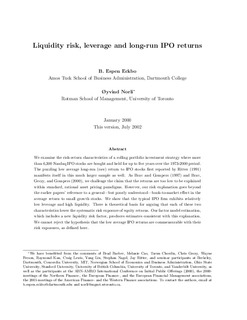Liquidity risk, leverage and long-run IPO returns
Working paper
Permanent lenke
http://hdl.handle.net/11250/163715Utgivelsesdato
2002-07Metadata
Vis full innførselSamlinger
- Discussion papers (FOR) [566]
Sammendrag
We examine the risk-return characteristics of a rolling portfolio investment strategy where more than 6,300 Nasdaq IPO stocks are bought and held for up to five years over the 1973-2000 period. The puzzling low average long-run (raw) return to IPO stocks first reported by Ritter (1991) manifests itself in this much larger sample as well. As Brav and Gompers (1997) and Brav, Geczy, and Gompers (2000), we challenge the claim that the returns are too low to be explained within standard, rational asset pricing paradigms. However, our risk explanation goes beyond the earlier papers’ reference to a general—but poorly understood—book-to-market effect in the average return to small growth stocks. We show that the typical IPO firm exhibits relatively low leverage and high liquidity. There is theoretical basis for arguing that each of these two characteristics lower the systematic risk exposure of equity returns. Our factor model estimation, which includes a new liquidity risk factor, produces estimates consistent with this explanation. We cannot reject the hypothesis that the low average IPO returns are commensurable with their risk exposures, as defined here.
Beskrivelse
January 2000
This version, July 2002
Utgiver
Norwegian School of Economics and Business Administration. Department of Finance and Management ScienceSerie
Discussion paper2002:2
